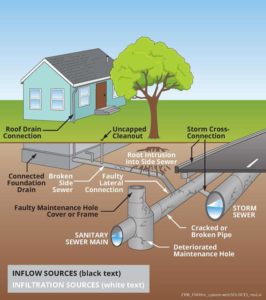Inflow and Infiltration
Few words give municipal managers more headaches than inflow and infiltration. Inflow and Infiltration (I&I) mitigation is an essential work that city utility, water, or sewer systems oversee. And, if you’re fortunate enough to have the capacity and funding, you know how critical a proactive approach to I&I can be in saving both the city and utility customers money and hassle.
Let’s recap what we’re talking about, and some best practices municipalities can implement to mitigate I&I issues…
WHAT ARE INFLOW AND INFILTRATION
Inflow and infiltration (I&I or I/I, as known within our industry) is excess water that flows into pipes. The source of this water is typically groundwater or stormwater.
Stormwater is known as inflow and can wreak havoc as it quickly flows into sewers from cross-connections, leaks, or holes around manhole covers or manholes, foundation drains, downspouts, and more.
Groundwater, on the other hand, is known as infiltration. This water flows slower, seeping through joint or mortar failures, poor connections, holes, cracks, and further damage.
An image created by King County, WA, provides excellent examples of common I&I sources.

Common Sources of Inflow and Infiltration, via King County, WA Wastewater Services. https://kingcounty.gov/services/environment/wastewater/ii/what.aspx The graphic is also available as a PDF file.
Municipal water managers know the constant feeling of this cat and mouse game, constantly chasing sources of I&I only to find another issue. There are remedies available (which we’ll discuss further), but these remedies are all for naught if the primary source is not identified.
A COMPREHENSIVE PLAN FOR INFLOW & INFILTRATION
First, your utility must create an approach that includes investigation, inspection, maintenance, and monitoring. Depending on the size of your municipality (and budget), this may be accomplished internally or by outsourcing some of these tasks to contractors and engineers.
It’s also helpful to remember that a decent percentage of your team’s work will be reactive — particularly if you do not already have a robust I&I plan. Infiltration and inflow issues are easy to put on the backburner because they only become emergent when it’s raining.
So, what does this look like?
INSPECTION
A standard tool for investigation and inspection is video trucks. CCTV and lateral launch trucks capable of regularly rotating through your town’s infrastructure will be significant in giving your department a clear picture (literally) of what’s going on within your lines. Create a regular schedule of line inspections via CCTV. Budget limited or short on employees? Something is better than nothing. Annual or even biannual inspections are still better than being in the dark. Flow monitoring (if equipped) can also be an effective tool for creating baselines in your data.
If your municipality is large enough, internal smoke testing by your team may be feasible. If not, this process can also be reasonably contracted out. Smoke testing allows utilities to pinpoint inflow, infiltration, and overflows. Smoke testing can be instrumental in determining issues with private laterals, allowing the city to inform customers of problems and prevent I&I issues on private property from flowing into city-managed systems.
UNDERSTANDING THE DATA
Flow monitoring, smoke testing, manhole inspections, and CCTV inspections are helpful, but only if your team (or an outside firm) can assemble actionable steps based on the data. Take the Mobile Alabama Area Water and Sewer System (MAWSS), for example. MAWSS began using this data to “more accurately compare dry versus wet weather flows. This enabled it to prioritize problem areas, typically 75,000 to 150,000 feet of isolated areas upstream of the flow monitors.”[1]
MAINTENANCE: REPLACE VS. REHABILITATE
Ideally, replacement would be preferred as infrastructure reaches (or far exceeds) its intended life. However, replacement is costly and wildly interruptive. Where you cannot replace it, rehabilitation is an excellent option, with far less disruption to the community. Rehabilitation (particularly with the right solution) can be incredibly cost-effective and fast.
Trenchless technologies and restorations like those from Sprayroq® are an excellent option for rehabilitating mains, laterals, and manholes. These options provide superior structural integrity for a fraction of the cost and downtime.
“I’m pushing trenchless rehab so hard because you can do so much more with so much less,” says Calressia Clark, director of field operations and logistics for MAWSS. “For its manhole rehabilitations, MAWSS has been using […] spray-applied polyurethane solutions from manufacturers like Sprayroq.”[2]
Sprayroq® products like SprayWall® and SprayShield Green® can allow service to resume almost immediately after rehabilitation, and give structural integrity that exceeds the original material.
In 2017, the City of Mishawaka, Indiana, utilized contractor Conco to apply a 250-mil lining of Sprayroq® SprayWall® to a deteriorating brick manhole. The application took less than an hour, and service was restored nearly immediately. The repair also withstood testing as the city used a 65,000-pound excavator to subject the manhole to multiple strikes. As the prior brick structure crumbled under the 8.82 psi ground pressure and bucket breakout pressure of 39,000 psi, the lining withstood the beating.[3]
CONCLUSION
Inflow and infiltration problems require constant diligence and thoughtfully planned use of resources. With the help of rehabilitative products (like the superior solutions offered by Sprayroq®), your utility can prevent issues and bring your infrastructure up-to-date without headaches, closures, and lengthy project timelines. Our team is available to resource your municipality as well! Reach out to our experts to find out how we can help your city with inflow and infiltration issues!
[1],2 Here’s What a Robust I&I Remediation Program Looks Like. Chin-Taylor, Suzan. 2021. https://www.iandimag.com/editorial/2021/10/a-package-plan
[3] Structural polyurethane liner proves itself in demonstration. https://www.iandimag.com/g/case-study/2017/09/structural-polyurethane-liner-proves-itself-in-demonstration.

